LG Electronics USA A340 Cellular/PCS GSM/EDGE/WCDMA Phone with Bluetooth User Manual
LG Electronics MobileComm USA, Inc. Cellular/PCS GSM/EDGE/WCDMA Phone with Bluetooth
Users Manual

LG
LG A340
User Guide
All screen shots in this guide are simulated.
Actual displays and the color of the phone may vary.
Some of the contents in this manual may differ from your phone
depending on the software of the phone or your service provider.
www.lg.comP/NO: MFL (1.0)

※ Part 15.21 statement
Change or Modifications that are not expressly approved by the
manufacturer could void the user's authority to operate the equipment.
.
.
.
.
※ Part 15.105 statement
This equipment has been tested and found to comply with the limits
for a class B digital device, pursuant to Part 15 of the FCC Rules.
These limits are designed to provide reasonable protection against
harmful interference in a residential installation. This equipment
generates uses and can radiate radio frequency energy and,
if not installed and used in accordance with the instructions,
may cause harmful interference to radio communications. However,
there is no guarantee that interference will not occur in a particular
installation. If this equipment does cause harmful interference or
television reception, which can be determined by turning the equipment
off and on, the user is encouraged to try to correct the interference
by one or more of the following measures:
- Reorient or relocate the receiving antenna.
- Increase the separation between the equipment and receiver.
- Connect the equipment into an outlet on a circuit different from that to
which the receiver is connected.
- Consult the dealer or an experienced radio/TV technician for help.

※ Part15 Class B Compliance
This device and its accessories comply with part15 of
FCC rules.
Operation is subject to the following two conditions:(1) This
device & its accessories may not cause harmful interference.
(2) This device & its accessories must accept any interference
received, including interference that may cause undesired
operation.
.
.
.
.
※ Body-worn Operation
This device has been tested for typical body-worn operations
with the distance of 0.69inches (1.5cm) from the user’s body.
To comply with FCC RF exposure requirements, a minimum
separation distance of 0.69inches(1.5cm) must be maintained
from the user's body. For example, this device must be
maintained from the user's body with an appropriate belt-clip
accessory.[More than 0.69inches(1.5cm)] Additionally, Belt
clips, holsters & other body-worn accessories may not contain
metallic components.
48
Utilisation comme
appareil portatif
Ce téléphone a été testé en vue
d'une utilisation type comme
appareil portatif, avec une
distance de 1 cm (0.39 pouces)
entre l'arrière de l'appareil et
le corps de l'utilisateur. Pour
satisfaire aux exigences de la
FCC en matière d'exposition
aux radiofréquences, on doit
maintenir une distance d'au
moins 1 cm (0.39 pouces)
entre le corps de l'utilisateur
et l'arrière du téléphone. Les
pinces de ceinture, les étuis et
autres accessoires semblables
d'autres marques et contenant
des composantes métalliques
ne doivent pas être utilisés.
Les accessoires portatifs qui
empêchent le maintien d'une
distance de 1 cm (0.39 pouces)
entre le corps de l'utilisateur
et l'arrière du téléphone et
qui n'ont pas été testés en
vue d'une utilisation type
comme accessoires portatifs
peuvent ne pas satisfaire
aux limites d'exposition aux
radiofréquences stipulées par
la FCC et, par conséquent, ne
doivent pas être utilisés.
Co
FC
Cet
son
Par
Co
et a
num
d’ I
So
aux
(1)
acc
pro
pré
et s
acc
reç
cau
ind
Sécurité
1.5 cm (0.69 pouces)
1.5 cm (0.69 pouces)
1.5 cm (0.69 pouces)
49
e
Conformité aux normes
FCC Part 15 Class B
Cet appareil et ses accessoires
sont conformes aux normes FCC
Part 15 Class B de la Federal
Communications Commission
et aux exigences pour appareils
numériques ICES-003 Class B
d’ Industrie Canada.
Son fonctionnement est sujet
aux deux conditions suivantes :
(1) Cet appareil et ses
accessoires ne doivent pas
provoquer de brouillage
préjudiciable, et (2) cet appareil
et ses accessoires doivent
accepter toutes les interférences
reçues, y compris celles pouvant
causer un fonctionnement
indésirable.

Your Phone
Phone Components

1. Earpiece: Lets you hear the caller during a
call.
2. Main LCD: Displays phone status icons,
menu items, web items, web information,
pictures and more, in full color.
3. Left soft key/Right soft key: Each of
these keys perform the functions indicated
by the text on the display immediately above
them.
4. Navigation keys
Standby Mode Hotkeys:
Contact List
New Message
IM
My Stuff
- In a menu: Navigates between menus.
5.
6.
7. Send key: Press this key in standby mode
to quickly access the most recent missed,
dialed, and received calls.
8. OK key
9. Clear key: Allows you to return to the
previous screen. Press and hold to activate
the Voice Command function.
10.
11.
12. End/Power key: Allows you to power
the phone on or off, end calls, or return to
standby mode.
13. Volume keys: Allows you to control the
Master Volume while in standby mode and
the earpiece volume during a call.
14. Charger/USB port
Your Phone

Rear view
Your Phone

Getting Started
Installing the SIM card and
battery
1. Remove the battery cover
Use your right thumb to press on the bottom
center of the battery cover, then slide the
cover upwards (as depicted below). Then, lift
the cover to remove it.
2. Remove the battery
Hold the top edge of the phone and use the
fingernail cutouts near the bottom of the
battery to lift the battery from the phone.
Warning
Do not remove the battery when the phone is
turned on; this can damage the phone.

Getting Started
3. Install the SIM card
Slide the SIM card into the SIM card slot
(as shown below). Make sure that the
gold contact area on the card is facing
downwards. To remove the SIM card, pull it
gently in the opposite direction.
4. Install the battery
Insert the top of the battery first into the top
edge of the battery compartment. Ensure
that the battery contacts align with the
terminals on the phone. Press the bottom of
the battery down until it snaps into place.

Getting Started
Charging your phone
Unfasten the cover of the Charger/USB port
on the left side of your phone. Insert the
charger connector to the phone (the ‘LG’ side
of the connector has to be facing up when
connecting to the phone) and then plug into
the wall socket. Your LG-A340 will need to be
charged until the Full Battery message appears
on the screen.
Important!
You must insert the battery before charging.
Warning
Use of unauthorized accessories could damage
your phone and void your warranty.

Installing a memory card
You can expand the memory available on your
phone by using a microSD™ memory card.
Tip
A memory card is an optional accessory.
Locate the microSD card slot on the right
side of the phone. Then, use your fingernail
to gently lift the cover.
The cover will remain attached to the phone,
so that it does not become lost.
With the microSD card facing up, slide it
into the microSD card slot (as demonstrated
in the following image).
Push the memory card in until it locks into
place.
Replace the slot cover on the phone.
1.
2.
3.
Note
If your memory card has existing content, it
will automatically be filed in the correct folder.
For example, videos will be accessible from the
Videos folder.
Getting Started
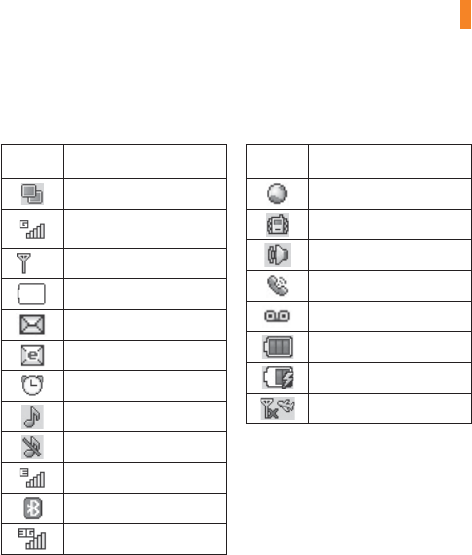
Getting Started
On-Screen Icons
The table below describes various display indicators or icons that appear on the phone’s display
screen.
ICON/
INDICATOR
DESCRIPTION
Multitasking
Network signal strength
(number of bars will vary)
No network signal
Low Battery
New text message
New email
An alarm is set
Ring profile in use
Silent All profile in use
EDGE network available
Bluetooth is active
3G network available
ICON/
INDICATOR
DESCRIPTION
The browser is active
Vibrating Mode On
Speakerphone
Call in Progress
Voicemail
Battery Full
Battery Charging
Flight Mode On

General Functions
Making a Call
Make sure your phone is powered on.
Enter a phone number including the area
code. To edit a number on the display
screen, simply press the key to
erase one digit at a time.
Ź
Press and hold the key to erase
the entire number.
Press the [SEND] key to call the
number.
To end the call, press the [END] key.
1.
2.
3.
4.
Making a Call with the Send Key
Press the [SEND] key, and the most
recent missed, dialed and received calls will
be displayed.
Highlight the desired number by using the
navigation keys.
Press the [SEND] key.
Making International Calls
Press and hold the key and the
international access character ‘+’ will
appear.
Enter the country code, area code, and the
phone number.
Press the [SEND] key to call the
number.
1.
2.
3.
1.
2.
3.

General Functions
Ending a Call
To end a call, press the [END] key.
Making a Call from the Contacts
You can store frequently called names and
phone numbers in the SIM card as well as in
the phone memory known as the Contacts.
You can dial a number by simply highlighting
a name in the Contacts List and pressing the
[SEND] key.
Press the [Down] key to access the
Contact List.
Highlight the Contact and press the
[SEND] key.
1.
2.
Answering a Call
When you receive a call, the phone displays
a notification on the screen and rings and/or
vibrates. If the caller can be identified, the
caller’s phone number (or name, if stored in
your Address Book) is displayed.
Press the [SEND] key or the left soft
key Accept to answer an incoming
call.
If the Answer Mode has been set as Any
Key ( Menu > Settings >
Call > Answer Mode), any key press
will answer a call, except for the
[END] key, the right soft key , or the
volume keys .
End the call by pressing the [END] key.
Note
You can answer a call while using other functions
or features.
1.
2.

Adjusting the Volume
Use the side volume keys during a call to
adjust the earpiece volume.
While in standby mode, you can adjust the
Master Volume using the side volume keys.
Vibrating Mode (Quick)
Vibrating Mode can be activated by pressing
and holding down the key.
Signal Strength
If you are inside a building, being near a
window may give you better reception. You can
see the strength of your signal by the signal
indicator on your phone’s display screen.
Entering Text
You can enter alphanumeric characters by
using the phone’s keypad. For example, storing
names in the Address Book, writing a message,
or scheduling events in the calendar all require
text to be entered.
Changing the Text Input Mode
Change the text input mode by holding down
when in a text entry field.
You can check the current text input mode in
the upper right corner of the screen.
The following text input modes are available
on the phone.
ABC Mode
This mode allows you to enter letters by
pressing the key labeled with the required
letter one, two, three, or four times until the
letter is displayed.
General Functions

General Functions
T9 Mode
The T9 mode allows you to enter words easily
with only one keystroke per letter. Each key
on the keypad has more than one letter.
The T9 mode automatically compares your
keystrokes with an internal linguistic dictionary
to determine the correct word, thus requiring
far fewer keystrokes than the traditional ABC
mode.
Note
You can select a different T9 language from
the Options menu (
Options > Text
Entry Settings > Text Entry Language).
123 Mode (Numbers Mode)
Type numbers using one keystroke per number.
To change to 123 mode in a text entry field,
press the key until 123 mode is displayed
in the upper right corner.
Symbol Mode
The Symbol Mode enables you to enter various
symbols or special characters. To enter a
symbol, press the key. Use the navigation
keys to highlight the desired symbol and press
the key.
Using the T9 Mode
The T9 predictive text input mode allows you to
enter words easily with a minimum number of
key presses. As you press each key, the phone
begins to display the characters that it thinks
you are typing based on a built-in dictionary.
As new letters are added, the word changes
to reflect the most likely candidate from the
dictionary.
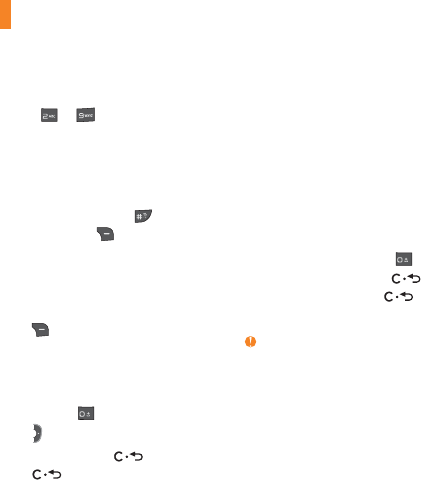
When you are in the T9 predictive text input
mode, begin entering a word by pressing
keys
to
. Press one key per letter.
Ź
The word changes as letters are typed
- ignore what is displayed on the screen
until the word is typed completely.
Ź
If the word is still incorrect after typing
completely, press the key or the
right soft key Next once (or more if
needed) to cycle through the other word
options.
Ź
If the desired word is missing from the
word choices list, press the right soft key
Add to add the word.
Enter the whole word before editing or
deleting any keystrokes.
Complete each word with a space by
pressing the
key or the right navigation
key .
To delete letters, press . Press and hold
down to erase all of the entered text.
1.
2.
3.
Using the ABC Mode
Use the alphanumeric keypad to enter your
text.
Press the key labeled with the required
letter:
Ź
Once for the first letter.
Ź
Twice for the second letter.
Ź
And so on.
To insert a space, press the
key once.
To delete letters, press the key.
Press and hold down the key to
erase all of the entered text.
Note
Refer to the table below for more information on
the characters available using the keys.
1.
2.
General Functions
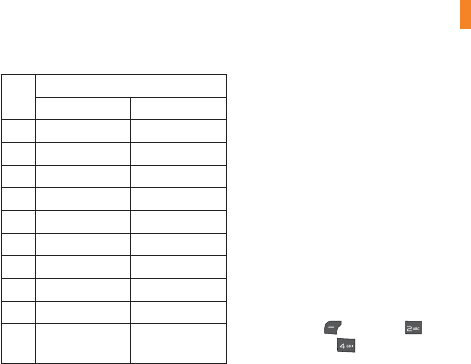
General Functions
Key Characters in the Order Displayed
Upper Case Lower Case
1 . , ’ @ ? ! - : / 1 . , ’ @ ? ! - : / 1
2 A B C 2 a b c 2
3 D E F 3 d e f 3
4 G H I 4 g h i 4
5 J K L 5 j k l 5
6 M N O 6 m n o 6
7 P Q R S 7 p q r s 7
8 T U V 8 t u v 8
9 W X Y Z 9 w x y z 9
0Space Key,
0 (Long press)
Space Key,
0 (Long press)
Using the 123 (Numbers) Mode
The 123 Mode enables you to enter numbers
in a text message (a telephone number,
for example) more quickly. Press the keys
corresponding to the required digits before
manually switching back to the appropriate text
entry mode.
T9 Dictionary
The T9 Dictionary is a feature that allows the
user to add any unique or personal words
to the T9 standard language database. The
T9 Dictionary function can be found in the
Options menu ( Options > Text
Entry Settings > T9 Dictionary). Within
the T9 Dictionary function, the user can add,
modify, delete, or reset personal words.
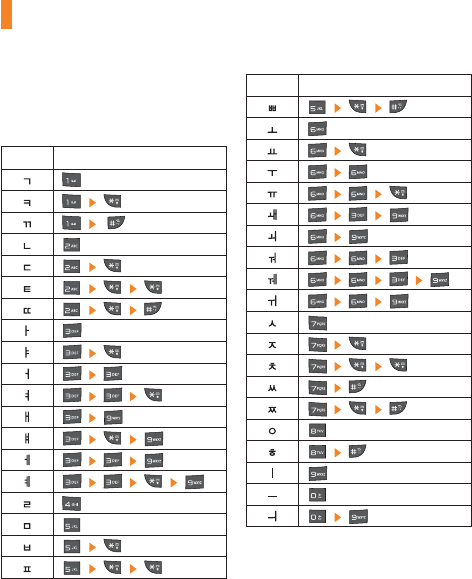
Using the Korean Mode
Allows you to type in Korean when you set the
language to Korean.
Keys Characters in the Order Displayed
Keys Characters in the Order Displayed
General Functions

In-Call Menu
During a Call
Your phone provides a number of control
functions that you can use during a call.
To access these functions during a call, press
the left soft key Options.
Making a Second Call
You can select a number you wish to dial from
the Address Book to make a second call.
Press the left soft key Options, then
select Address Book.
Highlight the contact, then press the
[SEND] key to make a second call.
Swapping Between Two Calls
Once the second call has been dialed (or
answered), you can switch between the calls
by using one of the following three methods:
Ź
Press the [SEND] key.
Ź
Press the left soft key Options and
then select “Swap Calls”.
Ź
Press Up/Down on the navigation key.
1.
2.
Answering an Incoming Call
To answer an incoming call when the handset
is ringing, simply press the [SEND] key.
The handset is also able to warn you of an
incoming call while you are already on a call. A
tone sounds in the earpiece and the display will
show that a second call is waiting. This feature,
known as Call Waiting, is only available if
your network supports it.
If Call Waiting is turned on, you can put the
first call on hold and answer the second call by
pressing the [SEND] key.
Rejecting an Incoming Call
You can reject an incoming call without
answering by simply pressing the
[END] key.

In-Call Menu
Muting the Microphone
You can mute the microphone during a call
by pressing the left soft key Mute. The
handset can be unmuted by pressing the left
soft key Unmute. When the handset is
muted, the caller cannot hear you, but you can
still hear the caller.
Using the Speakerphone
You can use the integrated Speakerphone
during a call by pressing the key.
The loudspeaker is automatically deactivated
when you end the call.
Warning
Due to increased volume levels, do not place
the phone near your ear while the speakerphone
is enabled.
Conference Calls
The conference call feature provides you with
the ability to have a simultaneous conversation
with more than one caller. The conference
call feature can be used only if your network
service provider supports this feature.
Once a conference call is set up, calls may
be added, disconnected (Exclude Call option
allows you to select a call to disconnect from
the conference call), or separated (Private
Call option allows you to separate a call from
the conference call, but still connected to
you) by the person who set up the conference
call. These options are all available from the
In-Call menu.

In-Call Menu
The maximum number of callers in a
conference call is five. Once started, you are in
control of the conference call, and only you can
add calls to the conference call.
Making a Second Call
You can make a second call while currently on
a call simply by entering the second number
with the keypad and pressing the [SEND]
key. When the second call is connected, the
first call is automatically placed on hold. You
can swap between calls by pressing the
[SEND] key.
Setting Up a Conference Call
To set up a conference call, place the first call.
Once that is connected, follow the steps above
to make a second call. You can then join the
two separate calls by pressing the left soft key
Options, selecting Conference Call,
and then Join Calls.
Place the Conference Call on
Hold
To place a conference call on hold, press the
[SEND] key.
Adding Calls to the Conference
Call
To add a call to an existing conference call,
press the left soft key Options, select
Conference Call, and then select Join Calls.
Private Call in a Conference Call
To have a private call with one of the callers in
the conference call, press the left soft key
Options, select Conference Call, and then
Private Call. When the numbers of the callers
are displayed, select the one with which you
wish to speak in private.
Ending a Conference Call
An active conference call can be disconnected
by pressing the [END] key.

Menu Tree
1. Address Book (see page 29)
1.1 Contact List
1.2 ICE - Emergency Contacts
1.3 New Contact
1.4 Caller Groups
1.5 Speed Dial Lists
1.6 SIM Management
1.7 Service Dial Numbers
1.8 My Contact Info
1.9 About
2. Messaging (see page 32)
2.1 Create Message
2.2 Inbox
2.3 Drafts
2.4 Outbox
2.5 Voice Mail
2.6 Message Settings
3. YPmobile (see page 40)
4. Mobile Web (see page 41)
5. AppCenter
6.
AT&T
AT&T Navigator (see page 42)
7.
AT&T
AT&T FamilyMap (see page 44)
8. Social Net (see page 45)
9.
AT&T
AT&T Radio (see page 46)
0. My Stuff (see page 47)
0.1 Audio
0.2 Pictures
0.3 Video
0.4
AT&T
AT&T GPS
0.5
AT&T
AT&T Music
0.6 Tools
0.7 Applications & Games
0.8 Camera & Recordings
0.9 Other Files
0.10 File Manager

*. Settings (see page 66)
*.1 Audio & Ringtones
*.1.1 Shop Tones
*.1.2 Ringtone
*.1.3 Message Tone
*.1.4 Alert Tone
*.1.5 Keypad Tones
*.1.6 Multimedia
*.1.7 Call
*.2 Phone Settings
*.2.1 Date & Time
*.2.2 Languages
*.2.3 Set Hotkeys
*.2.4 Set Flight Mode
*.2.5 Security
*.2.6 Reset Settings
*. Settings (continued)
*.3 Display
*.3.1 Shop Wallpapers
*.3.2 Wallpapers
*.3.3 Fonts
*.3.4 Clocks & Calendar
*.3.5 Brightness
*.3.6 Backlight Timer
*.3.7 Color Schemes
*.3.8 Menu Styles
*.4 Call
*.4.1 Call Forwarding
*.4.2 Send My Number
*.4.3 Auto Redial
*.4.4 Answer Mode
*.4.5 Senior Mode
*.4.6 Minute Minder
*.4.7 Call Waiting
*.4.8 Call Reject
*.4.9 Send DTMF Tones
*.4.0 Accessibility
*.4.* Time & Cost
*.4.# Noise Cancelation
Menu Tree

*. Settings (continued)
*.5 Connection
*.5.1 Bluetooth
*.5.2 USB Connection Mode
*.5.3 Internet Profiles
*.5.4 Access Points
*.6 Memory
*.6.1 Used Space
*.6.2 Set Storage Defaults
*.7 Application Settings
*.7.1 Messaging
*.7.2 Browser
*.7.3 Voice Command
*.7.4 TTS
*. Settings (continued)
*.8 Software Update
*.8.1 Check for Update
*.8.2 Continue Update
*.9 Phone Information
Menu Tree

Address Book
Contact List
This menu allows you to save and manage
contact address information. The Contact List’s
functions allow you to add a new address or
search saved contact addresses by name.
To access Contact List, from the standby
screen, press the right soft key Menu,
AT&T
AT&T Address Book, and Contact
List.
AT&T
AT&T Address Book Native Sync
(AAB)
AT&T
AT&T Address Book Native Sync (AAB) is a
service application for the synchronization of
phone contact list information with the AAB
server. When you turn on the phone or change
your SIM card, the AAB Start UP application is
displayed after entering the Address Book.
After checking the membership identification
for this service, you can find the menu for the
synchronization with the AAB server, from the
standby screen, by pressing the right soft key
Menu,
AT&T
AT&T Address Book,
Contact List, left soft key Options, and
AT&T
AT&T Address Book.
Ź
Auto Sync On/Off: This menu allows you
to synchronize your contact information with
AAB automatically.
Ź
Sync Now: Synchronize your contact
information with AAB now.
Ź
Sync Log: Shows recently synchronized
information.
Note
This
indicator is displayed during the AAB
synchronization.
ICE - Emergency Contacts

New Contact
This menu allows you to add a new contact to
the Contact List. You can enter contact address
information including name, phone numbers,
email addresses, group information items,
memos, ring tones, and a contact Picture ID.
To access New Contact, from the standby
screen, press the right soft key Menu,
AT&T
AT&T Address Book, and New
Contact.
Caller Groups
This menu allows you to manage group
information. You can also configure a ring tone
for a group so that the group ring tone sounds
when a call from a specific contact address
within that group is received and there is no
ring tone configured for the specific contact
address.
To access Caller Groups, from the standby
screen, press the right soft key Menu,
AT&T
AT&T Address Book, and Caller
Groups.
Speed Dial Lists
This menu allows you to assign a frequently-
called contact to the Speed Dial List. You can
select a number from 2 to 9 as a speed dial.
To access Speed Dial List, from the standby
screen, press the right soft key Menu,
AT&T
AT&T Address Book, and Speed
Dial List.
SIM Management
This menu allows you to copy information from
your SIM card to your handset and vice versa.
If a name is duplicated during the copying
operation, the information is also duplicated.
You can also delete information from the SIM
card.
To access SIM Management, from the standby
screen, press the right soft key Menu,
AT&T
AT&T Address Book, and SIM
Management.
Address Book

Service Dial Numbers
You can view the list of Service Dialing
Numbers (SDN) assigned by your network
provider. Such numbers could include the
emergency services, directory assistance and
voice mail numbers.
To access Service Dial Numbers, from the
standby screen, press the right soft key
Menu,
AT&T
AT&T Address Book, and
Service Dial Numbers.
My Contact Info
About
Allows you to view software the software
version and last update for Address Book.
To access About, from the standby screen,
press the right soft key Menu,
AT&T
AT&T
Address Book, and About.
Address Book

Messaging
This menu includes functions related to SMS
(Short Message Service), MMS (Multimedia
Message Service), Voicemail as well as the
network’s service messages.
Create Message
From the standby screen, press the right
soft key Menu.
Press Messaging.
Press Create Message.
OR
You can simply press [Up] from the
standby screen.
Note
If you insert a Picture, Audio, or Video file while
writing a multimedia message, the file loading
time will take about 5 seconds. You will not be
able to activate any key during the file loading
time. When the file loading is complete, you will
be able to write a multimedia message.
Editing a message
The following options are available when
editing a message.
1.
2.
3.
Using Insert
While entering text, press the left soft key
Insert.
Ź
Symbol: You can insert various symbols
into your message. Pressing the left and
right soft keys / scrolls through
the pages.
Ź
Picture: You can select a picture to insert
by using the navigation keys. You can
preview the selected picture by pressing the
left soft key View.
Ź
Audio: You can insert an audio file from
your saved audio files.
Ź
Video: You can insert a video clip from your
saved video clips.
Ź
Take New Picture: you can take and
insert a picture in your message.
Ź
Record New Audio: You can record a new
audio clip by pressing Record. Press
the left soft key Options before you
begin recording to set the options (below).
After recording a new audio clip, you can
delete it by pressing the right key
Delete.

Messaging
• Quality: Set the audio’s quality to Fine,
Normal, or Economy.
• Select Storage Defaults: You can
assign the default storage to Phone
Memory or Memory Card.
Ź
Record New Video: You can record a
new video by pressing Record. When
finished recording, press Insert.
Ź
Template
• Text: Allows you to easily insert frequently
used sentences in the text message.
• Multimedia: Preset multimedia templates
can be created ( Menu >
Messaging > Message Settings
> Multimedia Message >
Multimedia Templates > New).
• Signature: Allows you to insert your own
created signature. For further details, see
page 44.
Ź
More: Allows you to insert vCard,
vCalendar, vNote, vTask or Contact.
Note
vCard, vCalendar, vNote and vTask are created
by the Address Book, Calendar, Notepad, and
Tasks functions, respectively. Go to the Tools and
Address Book sections in this Manual for more
detailed information.
Using Options
While entering text, press the left soft key
Options.
• Text Entry Mode: Sets the text input mode.
For more details, refer to Entering Text
(page 21).
• Text Entry Settings:
- Text Entry Language allows you to
set the text entry language to English,
Spanish, French, or Korean.
- T9 Word Candidate List displays the
word candidates as you type.
- T9 Next Word Prediction allows the
phone to predict the next word when
typing in T9 mode.
- T9 Dictionary allows you to add, delete,
reset, and modify words.

Messaging
• Options of Add CC and Add Bc
• Save to Drafts: Saves the message to
Drafts.
• Cancel Message: Allows you to exit the text
input mode without saving your message.
Sending a Message
After completing a message, using Insert
and/or Options, press Send To to select
a recipient.
•
Enter the recipient(s). For more options, press
the left soft key
Options. In this menu,
you can choose from the following options:
- Enter Number: Allows you to enter the
phone number using the keypad.
- Enter Email: Allows you to enter an email
address instead of a phone number.
-
Insert Symbol: Allows you to enter symbols.
- Caller Groups: Displays Contacts Groups.
- Recent Messages: Choose a Contact
from Recent Messages.
- Recent Calls: Choose a Contact from
Recent Calls.
- Delivery Options: Allows you to set the
options for Delivery Receipt, Request Read
Receipt, Add Cc, and Add Bcc.
- Save to Draft: Saves the selected
message to Drafts.
- Text Entry Mode: Allows you to change
the text entry mode.
- Text Entry Settings: Allows you to set
the options for Text Entry Language,
T9 Word Candidate List, T9 Next Word
Prediction, and T9 Dictionary.
- Cancel Message: Allows you to cancel
the message.

Messaging
Inbox
You will be alerted when you receive a
message. New messages are stored in the
Inbox. In the Inbox, you can identify each
message by icons. If you are notified that you
have received a multimedia message, you can
download the whole multimedia message by
selecting it in the Inbox menu. To reach the
Inbox, from the standby screen, press the right
soft key
Menu >
Messaging >
Inbox.
The following options are available in the Inbox
and vary depending on the View mode set
(Conversation or Standard).
Ź
Add to Address Book: You can save the
sender’s phone number in the Contact List.
Ź
Delete: You can delete the selected
message.
Ź
Standard view: Switches the Inbox view
mode to Standard view.
Ź
Forward: You can forward the selected
message to another person.
Ź
Copy to Phone/Copy to SIM: You can
copy to Phone or SIM depending on where
the text message is stored.
Ź
Select Multiple: You can select multiple
messages.
Ź
Message Details: You can view the
following information about received
messages: message Type, Subject, From,
and message Time.
Ź
Delete All Read Messages: You can
delete all read messages.
Ź
Conversation view: Switches the Inbox
view mode to Conversation view.
Drafts
Allows you to view and edit the messages
saved as drafts. To access drafts, from the
standby screen, press the right soft key
Menu,
Messaging, and Drafts.
The following options are available for the
Drafts folder:
Ź
Select Multiple: Allows you to select
multiple messages to delete.
Ź
Message Details: Allows you to view the
details of the message.

Messaging
Outbox
Outbox is the storage place for recently sent
messages. When you press the [SEND]
key, you can call the recipient of the selected
message.
If the message is not sent from the Outbox,
you will receive a sound alert along with a
Message Sending Failure notice on the screen.
Another attempt will be made to send the
failed message and after two unsuccessful
attempts, the message will no longer be sent
automatically. In order to send the message
that has failed, you must press the left soft key
Resend to resend the message.
To access the Outbox, from the standby
screen, press the right soft key Menu,
Messaging, and Outbox.
The following options are available for the
Outbox folder:
Ź
View Status: Shows the status of each
message.
Ź
Delete: Deletes the selected message.
Ź
Edit: Allows you to edit the selected
message.
Ź
Select Multiple: Allows you to select
multiple messages to delete.
Ź
Message Details: Allows you to view the
details of the message.
Voicemail
This menu provides you with a quick way of
accessing your voice mailbox (if provided by
your network).
A shortcut for checking your voicemail is
available. To quickly check your voicemail when
in standby mode, press and hold the key.
Note
Please check with your network service provider
for details of their service in order to configure
the handset accordingly.

Messaging
Message Settings
To access and configure your Message
Settings, from the standby screen, press the
right soft key Menu, Messaging,
and Message Settings.
Message Alert
Allows you to set the Sounds, Volume, and
Alert Type.
Save To
Allows you to choose whether to save to the
SIM Card or the Phone.
Signature
Allows you to create, edit, and delete your
signature, which can be configured to be sent
out with your outgoing messages.
Text Message
Allows you to set preferences for text
messages.
The following options are available:
Ź
Text Templates: Predefined messages
that can quickly be sent. Press the left soft
key Options to access the following
available options:
• Send: Allows you to send the selected
template via Message.
• Delete: Allows you to delete the selected
template message.
• Edit: Allows you to edit the selected
template message.
• Delete All: Deletes all messages in the
folder.
Ź
Message Center Number: Allows you to
view and edit the phone number for the
Message Center. Do not edit unless instructed
to do so by your service provider.
Ź
Email Gateway: Allows you to view and
edit the Email Gateway. Do not edit unless
instructed to do so by your service provider.
Ź
Message Subject: Allows you to enable or
disable the Subject field in an SMS.
Ź
Insert Signature: Allows you to insert your
signature in outgoing messages.

Messaging
Multimedia Message
Allows you to set your preferences for
multimedia messages.
The following options are available:
Ź
Multimedia Templates: Allows you to
add, edit, and delete multimedia templates.
Press the left soft key Options to
access the following available options:
• Send: Allows you to send the selected
message via Multimedia Message.
• Delete: Allows you to delete the selected
template message.
• Edit: Allows you to edit the selected
template message.
• Rename: Allows you to rename the
selected template message.
• Delete All: Allows you to delete all the
messages at one time.
Ź
Priority: Allows you to set the priority of
the message.
Ź
Message Subject: Allows you to enable or
disable the Subject field in an MMS.
Ź
Validity Period: This network service
allows you to decide how long your
multimedia messages will be stored at the
Message Center.
Ź
Send Delivery Receipt: Allows you to
send a delivery confirmation notification for
a Multimedia Message.
Ź
Send Read Receipt: Allows you to send a
message read confirmation notification for a
Multimedia Message.
Ź
Download Options
• Download Without Ask: Allows
Multimedia Messages to be downloaded
automatically.
• Ask Always: You are prompted to
download when a Multimedia Message is
received.
• Discard: Enabling this option will block
incoming Multimedia Messages from
being received.
Ź
Message Center: Allows you to view and
edit the phone number for the Message
Center. Do not edit unless instructed to do
so by your service provider.

Messaging
Voicemail Number
This menu allows you to set the Voicemail
Center Number if this feature is supported by
AT&T
AT&T. Please check with
AT&T
AT&T for details of
their service in order to configure the handset
correctly.
Service Message
Allows you to configure your settings to
determine if you would like to receive service
messages.

YPmobile
Unleash the power of YELLOWPAGES.COM
local search on your mobile phone.
Find a business, get maps and directions, and
save your favorites: our mobile app gives you
what you need, whenever and wherever you
need it.
Ź
Search for local businesses.
Ź
View ratings and call businesses.
Ź
Save businesses for future access.
Ź
Get maps and view step-by-step directions.
* For more information, refer to the www.
yellowpage.com
To access YPmobile, from the standby screen,
press the right soft key Menu and then
YPmobile.

Mobile Web
Mobile Web is one of the services provided by
AT&T
AT&T and it gives you access to all the cool
things you can do with your wireless phone.
Note
Check the availability of services, pricing, and
tariffs with your network operator and/or the
service provider whose service you wish to use.
Service providers will also give you instructions
on how to use their services.
Please contact your service provider to open an
Internet account.
Launch the Browser
To launch the browser from the standby
screen, press . You can also press the right
soft key Menu and Mobile Web.
Once connected, the homepage is displayed.
To exit the browser at any time, press the
[END] key.
Using the Browser
Once you are connected to the Internet, the
following menu options are available when you
press the left soft key Options:
Ź
Home: Directs you to the homepage.
Ź
History: Allows you to view your history of
recently viewed web sites.
Ź
Go to Bookmarks: You can add or save
the current page to Booksmarks or view the
list saved under Booksmarks.
Ź
Reload: Allows you to reload the current
web page so that you can view the newest
content.
Ź
Find in Page: Allows you to search for text
in the current web page.
Ź
Settings: Allows you to set options for web
pages, appearance, and network.
Ź
Help: Connects you to
AT&T
AT&T’s Help web
page.
Ź
Exit: Exits the browser.
Menus for the Browser
You can surf the Internet using either the
phone keys or the Browser menu.
Using the Navigation Keys
When surfing the Internet, the navigation keys
function similarly from when the phone is on
standby mode.

Navigator
The
AT&T
AT&T Navigator application on your device
uses GPS position determination technology
and access to your carrier’s data network to
provide you with driving directions and a host
of other services, including:
Ź
GPS navigation that gives you turn-by-turn
directions to any destination address in
the continental United States. If you miss
a turn or get off-track,
AT&T
AT&T Navigator
will calculate a new route for you. You can
enter a destination address by using
AT&T
AT&T
Navigator’s automatic voice recognition
system or by typing on the device’s keypad.
Ź
Audio and visual traffic alerts while driving
or viewing maps, as well as traffic re-
routing capabilities to minimize delays on
your trip.
Ź
A Search feature that allows you to find
businesses or points of interest near your
current location, an airport, a waypoint, or
any other entered address. You can read
ratings and reviews for businesses and
easily call the business that you have found
to check on the availability of an item or to
make a reservation. You can navigate to the
business location now or save the address
for later use.
Ź
Maps of the area around your current
location, around a marked waypoint, or
around an address that you had previously
entered. You can pan the map (adjust left,
right, up, or down) and zoom in or out.
You can also mark a point under the cursor
as a waypoint.
Ź
A compass-like indicator presenting your
direction of travel, location, and speed.

Ź
The ability to personalize your application
preferences by selecting U.S. customary
or metric distance units, the language for
audible guidance, and more.
You can also use many of
AT&T
AT&T Navigator’s
features on the TeleNav website, such as
getting driving directions (Route Planning) and
using the Search function to find businesses,
churches, schools, and government offices. You
can also use the TeleNav website to add an
address to your My Favorites list, manage your
My Favorites and Recent Places lists, and shop
at the TeleNav Store.
To access
AT&T
AT&T GPS,from the standby screen,
press the right soft key Menu,
AT&T
AT&T
GPS, and
AT&T
AT&T Navigator.
Note
For best GPS performance.
Ź
In order to improve GPS antenna sensitivity,
do not cover the GPS antenna area of the
device.
Ź
Your GPS antenna sensitivity might be
weakened if you are in a high rise building,
underground, or location surrounded by metal
or concrete.
Ź
Use near the window indoors for better GPS
antenna sensitivity.
Ź
For battery durability, please use a vehicle
power adapter in your car.
Ź
It could take 2~3 minutes to get your GPS
position depending on the condition of the
environment or network.
AT&T
AT&T Navigator

FamilyMap

Social Net

Radio

My Stuff
Audio
To access Audio, from the standby screen,
press the right soft key Menu, My
Stuff, and Audio.
Ź
Shop Tones: This menu option connects to
AT&T
AT&T’s Ringtones download site.
Ź
Record Voice: Allows you to record voice
notes.
Ź
Saved audio files are displayed in the list.
Picture
To access Picture, from the standby screen,
press the right soft key Menu, My
Stuff, and Picture.
Ź
Shop Wallpapers: Connects to
AT&T
AT&T’s
Color Graphics download site.
Ź
The picture files saved on your phone and
memory card (if inserted) are displayed.
Video
To access Video, from the standby screen,
press the right soft key Menu, My
Stuff, and Video.
Ź
Shop Videos: Connects you to
AT&T
AT&T’s
Videos download site.
Ź
The video files saved on your phone and
memory card (if inserted) are displayed.
Note
DRM sometimes restricts some functions, such
as send and edit.
AT&T
AT&T GPS
The
AT&T
AT&T Navigator application on your device
uses GPS position determination technology
and access to your carrier’s data network to
provide you with driving directions and a host
of other services, including:
Ź
GPS navigation that gives you turn-by-turn
directions to any destination address in
the continental United States. If you miss
a turn or get off-track,
AT&T
AT&T Navigator
will calculate a new route for you. You can
enter a destination address by using
AT&T
AT&T
Navigator’s automatic voice recognition
system or by typing on the device’s keypad.
Ź
Audio and visual traffic alerts while driving
or viewing maps, as well as traffic re-
routing capabilities to minimize delays on
your trip.

Ź
A Search feature that allows you to find
businesses or points of interest near your
current location, an airport, a waypoint, or
any other entered address. You can read
ratings and reviews for businesses and
easily call the business that you have found
to check on the availability of an item or to
make a reservation. You can navigate to the
business location now or save the address
for later use.
Ź
Maps of the area around your current
location, around a marked waypoint, or
around an address that you had previously
entered. You can pan the map (adjust left,
right, up, or down) and zoom in or out.
You can also mark a point under the cursor
as a waypoint.
Ź
A compass-like indicator presenting your
direction of travel, location, and speed.
Ź
The ability to personalize your application
preferences by selecting U.S. customary
or metric distance units, the language for
audible guidance, and more.
You can also use many of
AT&T
AT&T Navigator’s
features on the TeleNav website, such as
getting driving directions (Route Planning) and
using the Search function to find businesses,
churches, schools, and government offices. You
can also use the TeleNav website to add an
address to your My Favorites list, manage your
My Favorites and Recent Places lists, and shop
at the TeleNav Store.
To access
AT&T
AT&T GPS,from the standby screen,
press the right soft key Menu,
AT&T
AT&T
GPS, and
AT&T
AT&T Navigator.
Note
For best GPS performance.
Ź
In order to improve GPS antenna sensitivity,
do not cover the GPS antenna area of the
device.
Ź
Your GPS antenna sensitivity might be
weakened if you are in a high rise building,
underground, or location surrounded by metal
or concrete.
Ź
Use near the window indoors for better GPS
antenna sensitivity.
Ź
For battery durability, please use a vehicle
power adapter in your car.
Ź
It could take 2~3 minutes to get your GPS
position depending on the condition of the
environment or network.
My Stuff

AT&T
AT&T Music
You can access
AT&T
AT&T Music by pressing the
right soft key Menu,
AT&T
AT&T Music,
and Music Player.
Music Player
Ź
All Songs: Allows you to view all the songs
in your music library.
Ź
Playlists: Allows you to create your own
playlists.
Ź
Artists: Shows the list of artists of all the
songs in your music library, and shows all
the songs by a chosen artist.
Ź
Albums: Shows the list of albums of all the
songs in your music library, and shows all
the songs on a chosen album.
Ź
Genres: Shows the list of genres of all the
songs in your music library, and shows all
songs of a specific genre.
Ź
Shuffle Songs: Allows you to play all the
songs in your music library in random order.
Tip!
The music player plays formats such as MP3,
AAC, AAC+, and WMA.
Note
Copyrights of music files may be protected by
copyright and intellectual property laws. Please
ensure that you adhere to the applicable Terms
of Use of materials laws prior to downloading or
copying files.
To play songs from or transfer songs to SD card,
the SD card should have some empty space.
Up to 512MB card: Require 3MB empty space
Up to 4GB card: Require 6MB empty space
Up to 16GB card: Require 20MB empty space
(Up to 1000 songs)
My Stuff
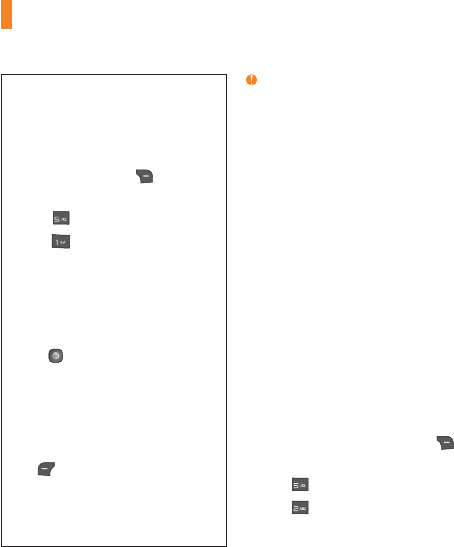
Playing Music
To listen to music that you have transferred
to your phone, follow these quick easy steps:
Playing Music with the Slide Open
Press the right soft key Menu to
open the Main Menu.
Press
AT&T
AT&T Music.
Press Music Player to view your
options. You can select from Now Playing,
All Songs, Playlists, Artists, Albums and
Genres to select your Music or you can
just select Shuffle Songs to shuffle your
collection.
• Press to Play/Pause a selected
song. While playing, press the up or down
navigation keys to change the volume and
the left or right navigation keys to go to
the previous or next song.
• While playing music, press the left soft
key Minimize to minimize the music
player and access other phone functions
while music is playing.
1.
2.
3.
Note
Files under 300kb are stored as ringtone files.
Adding Music To Your Handset
Music files can be added to your handset by
using one or more of the following methods:
• Download music and ringtones over the
AT&T
AT&T network directly to your device via the
Shop Music link in the
AT&T
AT&T Music Folder
or the Shop Tones link in the Audio folder.
• From your existing digital media collection on
your PC via Windows Media
®
Player and/or
Windows Explorer.
• From your PC using other music subscription
services, such as Napster or eMusic.
Purchasing and downloading Music
directly to your Device
With Slide open, press right soft key
Menu to open the Main Menu.
Press
AT&T
AT&T Music.
Press Shop Music.
1.
2.
3.
My Stuff

Navigate the Shop Music page to
download today’s hottest music, ringtones,
and other personalized content directly to
your phone.
Note
Some sites are data intensive (i.e. previews via
streaming) so the user should be enrolled in an
unlimited data plan before using these services
to avoid per-use data charges.
Additional charges may apply when downloading
music, ringtones etc.
Transferring Music using your PC
Before You Get Started
To transfer music from your PC to your device,
you will need the following:
• Windows Media
®
Player 10 (or above) or
other digital music management software,
such as Napster or eMusic.
• Music on your PC in one of these formats:
MP3, .AAC, AAC+ or WMA
• A MicroSD™ card*
(supports up to 16GB cards)
• USB data cable*
* MicroSD™ card and USB data cable sold
4.
separately; go to att.com/wireless for details.
Note
This device is not compatible with iTunes and/or
iTunes files.
Transferring Music from the Digital
Music Service (such as Napster or
eMusic)
Using your computer, open your preferred
PC music management client.
Download the selected song to your library.
Make sure the microSD™ card is inserted
properly into the handset.
Use the USB adapter cable to connect the
handset to the PC.
Once the USB connection has been
established, the handset displays “Do
not disconnect during transfer”. The PC
screen will display a pop-up message
announcing the detection of the LG-A340
device. If the detection does not occur, the
USB connection settings may need to be
changed. For more information, go to the
Changing USB Connection Settings
section on page 53.
1.
2.
3.
4.
5.
My Stuff

Follow the music service instructions to
transfer music to your handset.
Note
If you have a USB hub, connect the handset
directly to your computer rather than through
the hub.
Transferring Music using Windows
Media Player
Open Windows Media® Player on your
computer (version 10.0 or higher).
Use the USB adapter cable to connect the
handset to the PC.
Once the USB connection has been
established, the handset displays “Do not
disconnect during transfer”. The PC screen
will display a pop-up message announcing
the detection of the LG-A340 device.
6.
1.
2.
3.
Note
If you have a USB hub, connect the handset
directly to your computer rather than through
the hub. If the target computer does not detect
the newly connected handset or provide an MTP
Player dialog window on the PC screen, or if the
detection does not occur, skip to
Changing
USB Connection Settings
section on page
53.
From within the Windows Media
®
Player
application, click on the Sync tab.
Choose the destination location for the
media files. The LG-A340 Music Sync Player
appears on the right side of the screen.
Note
If there are no items present in the playlist,
click the Edit Playlist button and begin adding
the music files from among the various media
categories.
Drag the songs you wish to synchronize to
your LG-A340 to the Sync List column on
the right side of the screen.
Click the Start Sync button at the lower
right corner of the application to download
the selected songs to your handset. Do not
unplug the handset during this process.
4.
5.
6.
7.
My Stuff

Once synchronization is complete, it will
be safe to unplug the USB connector from
the handset.
Drag and Drop Music Using LG-A340 As
A Mass Storage Device
Insert a microSD™ memory card into the
phone and make sure it is powered on.
Connect the device to a PC using a LG-
A340 USB data cable.
Access My Computer on the PC.
Locate the phone and double-click it to
open.
Note
The PC will automatically assign a drive letter.
Browse the files in a new window for
desired music files.
Drag and drop the desired music content
from the PC window to the “Storage Card”
window.
Disconnect the device from the cable.
Access the Music Player on the phone.
8.
1.
2.
3.
4.
6.
7.
8.
9.
Note
If the target computer does not detect the newly
connected handset as Mass Storage, skip to
the
Changing USB Connection Settings
section below.
Changing USB Connection Settings
From the standby screen, press the right
soft key Menu.
Press Settings.
Press Connection.
Press USB Connection Mode.
Use the Up or Down Navigation key to
highlight Music Sync (if using Windows
Media® Player or other Digital Music
Services) or Mass Storage (if you are going
to drag or drop files) and press Select.
Reconnect the device to a PC.
1.
2.
3.
4.
5.
6.
My Stuff

Deleting Music Files
When you have transferred files with the Music
Sync feature and you want to delete them from
your phone, you should connect the phone
to your PC and delete using the method with
which you first added the music. The following
are the four options available to delete Music
from your Phone:
A. Delete a file using Mass Storage, but not
using Music Sync function.
B. Delete a file by directly inserting the
microSD™ external memory onto the PC.
C. Delete a file using the delete function on
the phone.
D. Delete the files by using the Master Clear
option on your Memory Card.
Note
Be aware that all of the existing data will be
erased on microSD™ card if you use the Master
Clear option.
Access the
Master Clear
function in the
Settings menu (see page 69).
Tools
Voice Command
Voice Command is the function whereby your
phone’s voice recognition engine identifies the
voice of the user and carries out the requested
commands. When the user operates the Voice
Command function, there are five possible
commands, Call <Name or Number>, Listen
Voicemail, Missed Calls, Messages, and Time &
Date. To activate the Voice Command function,
hold down the Clear Key while the
phone is in standby mode or press the right
soft key Menu, My Stuff,
Tools, and Voice Command.
Call <Name or Number>: This function
is activated only when the user says the
command “Call” followed by the name
stored in the address book or say the
phone number. Please note that interfering
noise might cause a problem displaying
candidates. Additionally, the user has the
option to select a number type at the end,
such as “mobile”, “home”, or “work”.
1.
My Stuff

Listen Voicemail: This command is
activated when the user says “Listen
Voicemail”. The user will then be
automatically connected to voicemail.
Missed Calls: This command is activated
when the user says the words “Missed
Calls”. The mobile phone presents the
missed call list.
• Follow-up Commands Available
- Yes: Make the phone call.
- No: Moves to the next result.
- Cancel: Go back to the main Voice
Command menu.
- Exit: Terminate Voice Command.
- Next: Moves to the next result.
Messages: This command is activated
when the user says “Messages”. The phone
displays details of unread SMS or MMS
messages.
Time & Date: This command is activated
when the user says “Time & Date”. The
phone displays the current local time and
date.
2.
3.
4.
5.
Voice Command Options
When the Voice Command option is activated,
you can press the left soft key Options
for the following options:
• Mode
- Speed: Voice Command is abbreviated.
- Normal: Voice Command is played
normally with prompts.
• Best Match
- 1 Match: The most likely match will be
displayed when finding a number from the
address book.
- 4 Matches: The four most likely matched
names will be displayed when finding a
name from the address book.
• Sensitivity
- High: Operation and performance of
the voice recognition engine is rarely
affected by the user’s voice command and
surrounding sound.
My Stuff

- Medium: Operation of the voice
recognition engine is normally affected by
user’s voice command and surrounding
sound.
- Low: Operation of the voice recognition
engine is strongly affected by user’s voice
command and surrounding sound.
• Speakerphone Mode
- Automatic On: When this option is
selected, sound is loud enough so you can
hear the output when the phone is away
from the ear, at a distance
- Off: When this option is selected, sound
is quieter and cannot be heard when the
phone is away from the ear, at a distance
• Call Alert
- Ring Only: The phone rings repeatedly
during an incoming call.
- Ring After Name: The phone announces
the name or number of the incoming call,
then rings repeatedly.
- Name Repeat: The phone announces an
incoming call by repeating the name or
number of the caller.
Recent Calls
This menu displays recent calls categorized by
tab as All/Missed/Dialed/Received.
To access Recent Calls, from the standby
screen, press the left soft key Menu,
My Stuff, Tools, and Recent Calls.
Alarm Clock
The alarm function allows you to set up
multiple separate alarms. You can also set the
time, repetition interval, and alarm tone.
To access Alarm Clock, from the standby
screen, press the right soft key Menu,
My Stuff, Tools, and Alarm
Clock.
If there is no alarm setting, press the left soft
key New to add a new alarm.
My Stuff

Alarm Options
Ź
Time: Input your desired alarm time by
specifying the hour and minutes. You can
also choose a predefined amount of time
(15 Minutes Later, 30 Minutes Later, 45
Minutes Later, 1 Hour Later, Off).
Ź
Repeat: Select the desired repeat mode
(Once, Daily, Mon ~ Fri, Sat ~ Sun, Except
Holiday, Select Weekday).
Ź
Alarm Tone: Press List to access the
list of available Alarm Tones.
Ź
Volume: Select the desired volume level
using the up/down navigation keys or the
number keys ( to ). Then, press
Set.
Ź
Type: Select the desired alert type from
Ring, Vibrate, Ring & Vibrate, and
Vibrate after Ring.
Ź
Memo: Input alarm name.
Press the left soft key Save to save your
new Alarm.
Calendar
When you enter this menu, a calendar will
be displayed. The red square cursor is used
to locate a particular day. The bottom bar on
the calendar indicates saved schedules (if
any) for that day. This function helps you keep
track of your schedule. The phone can sound
an alarm tone if it has been set for a specific
schedule item.
The chart below shows the keys that can be
used to navigate the Calendar:
Key Description
key / key Weekly
key / key Daily
key / key Annually
key / key Monthly
To access Calendar, from the standby screen,
press the right soft key Menu, My
Stuff, Tools, and Calendar.
The following options are available when a
Calendar event is selected from the Calendar
menu.
Ź
Search: Allows you to search the saved
schedule(s).
My Stuff

Ź
Delete: Allows you to delete the selected
schedule.
Ź
Send Schedule Via: Sends the selected
schedule by Text Message, Multimedia
Message, or Bluetooth.
Ź
Set Holiday: Allows you to set specific
dates to display as Holidays on your
calendar.
Ź
Selective Delete: Allows you to delete Old
Schedules or All Schedules selectively.
Ź
View All: Allows you to view all saved
schedules.
Ź
Go to Date: Allows you to jump to a
specific date.
Ź
Select Multiple: Allows you to select
multiple schedules in the same day to
delete or send to another person.
Ź
Cancel: Allows you to cancel the edition of
the selected schedule.
Notepad
You can create up to a maximum of 30
memos.
To access Notepad, from the standby screen,
press the right soft key Menu, My
Stuff, Tools, and Notepad.
Press the left soft key New to create
a new memo.
Input the memo and press Save to
save.
Calculator
The Calculator function allows you to calculate
simple mathematical equations.
To access Calculator, from the standby screen,
press the right soft key Menu, My
Stuff, Tools, and Calculator.
World Clock
The World clock function provides time
information for major cities worldwide.
To access World Clock, from the standby
screen, press the right soft key Menu,
My Stuff, Tools, and World
Clock.
You will be asked to enter the name of your
current city. Enter the name, then press the
right soft key Save.
To view the time in another city, press the
right soft key New, find the city, and
set the Daylight Savings Time.
1.
2.
1.
2.
My Stuff

Press the right soft key Save to save
the new city.
You will then see the new city’s time and date
information.
Tasks
This feature allows you to save and manage
a task.
To access Tasks, from the standby screen,
press the right soft key Menu, My
Stuff, Tools, and Tasks.
To add a new task item, press the left soft
key New.
Input the Due Date, Note, Priority, and
Status information for the new Task.
Press the left soft key Save to save
the Task item.
The following options are available in the
Task list:
Ź
Mark ‘Complete’: Allows you to change
the status of the selected task as
Completed.
Ź
Edit: Allows you to edit a saved task.
Ź
Delete: Deletes the selected task.
3.
1.
2.
3.
Ź
Selective Delete: Allows you to delete All
Completed/All Past Tasks selectively.
Ź
Send Task Via: Enables the selected task
to be sent via Text Message, Multimedia
Message, or Bluetooth.
Ź
Select Multiple: Allows you to select
multiple Tasks.
Ź
View Calendar: Allows you to view the
Calendar.
Ź
Cancel: Cancels the task editing and
returns to the Tools menu.
Stopwatch
This menu allows you to record the elapsed
time of an event. The duration of an individual
lap time (up to 20 laps) and the total time can
also be displayed.
To access Stopwatch, from the standby screen,
press the right soft key Menu, My
Stuff, Tools, and Stopwatch.
Ź
New Time
To start timing, press Start. The
running time is displayed as HH.MM.SS.hh
(hours, minutes, seconds, hundredths of
a second).
1.
My Stuff

During the timing, you can record an
individual lap time by pressing the right
soft key Lap. Up to 20 lap times can
be recorded.
You can stop or restart timing by pressing
again.
To reset the stop watch, press Stop
to stop the time, then press the left soft
key Reset.
Ź
Saved Times: You can see the saved
recorded times.
Tip Calculator
This feature allows you to quickly and easily
calculate the tip amount based on the total bill
as well as the split of the total bill based on the
number of people.
To access Tip Calculator, from the standby
screen, press the right soft key Menu,
My Stuff, Tools, and Tip
Calculator.
2.
3.
4.
Unit Converter
This function allows you to convert units of
measurement.
There are 7 types of units that can be
converted: Currency, area, length, weight,
temperature, volume and velocity.
To access Unit Converter, from the standby
screen, press the right soft key Menu,
My Stuff, Tools, and Unit
Converter.
Note
You can input a decimal by pressing the
[POUND] key.
Applications & Games
To access Games, from the standby screen,
press the right soft key Menu, My
Stuff, and Games.
Ź
Shop Games: This menu option connects
to
AT&T
AT&T’s Games download site.
Ź
Downloaded games are displayed in the list.
My Stuff

Note
The JAR file is a compressed format of the Java
program and the JAD file is a description file
that includes all detailed information. From the
network, prior to download, you can view all
detailed file descriptions from the JAD file.
Warning
Only J2ME (Java 2 Micro Edition) based
programs will run on a phone.
J2SE (Java 2 Standard Edition) based programs
will only run on a PC.
Camera & Recordings
To access Camera & Recordings, from the
standby screen, press the right soft key
Menu, My Stuff, and Camera &
Recordings.
Take Photo
Using the camera module built into your phone,
you can take pictures of people or events while
on the move. Additionally, you can send photos
to other people in a picture message.
The following options will appear (as icons) at
the bottom of the screen.
Ź
Album: Allows you to see saved image and
video files.
Ź
Video: Allows you to switch to Camcorder
mode.
Ź
Capture: Allows you to capture the image.
Ź
Zoom: Allows you to set the zoom level.
Ź
Video Share: If available, this will allow you
to initiate a Video Share call.
The left soft key Settings will bring up
the following options:
Preview Tab
Ź
Image Size: The resolution of the image
can be captured in 1280*960, 640*480,
320*240, or 160*120.
Ź
View Mode: Set the View Mode as View
Full Screen or View Full Image.
Ź
Brightness: Adjust brightness with a slider
by using the navigation key.
Ź
Color Effects: Allows you to choose from
Color, Mono, Sepia, or Negative.
Ź
White Balance: Set the White Balance
as Auto, Daylight, Cloudy, Illuminate, or
Indoors.
Ź
Night Mode: On/Off
My Stuff
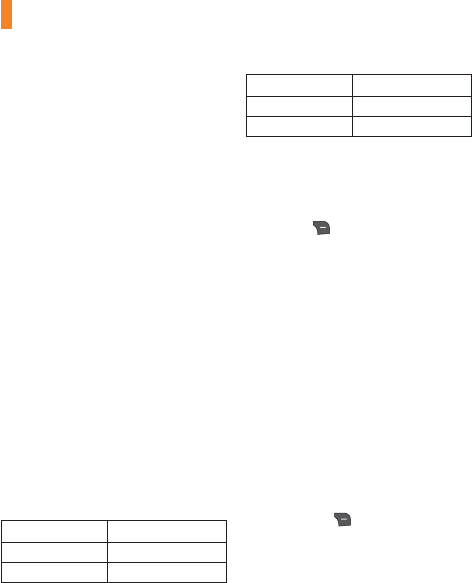
Ź
Timer: Timer can be set to Off, 3 Seconds,
5 Seconds, or 10 Seconds.
Ź
Continuous Shot: This is great for taking
photos of moving objects or at sporting
events. The continuous shot is only
available in QVGA(320x240) mode and can
be set to Off or 3/6/9 shots per event.
Ź
Image Quality: The quality of the captured
image can be set to Super Fine, Fine, or
Normal.
Others Tab
Ź
Hide Icons: Select from Auto or Manual.
Ź
Shutter Tones: You can choose from Tone
1, Tone 2, Tone 3, or Off.
Ź
Reset Settings: Allows you to set the
Camera to the default settings.
Using Zoom
In Take Photo mode, you can Zoom in/out
by using the up/down side volume keys. The
maximum zoom scale depends on the resolution
as follows.
Resolution Zoom scale
1280*690 Not Available
640*480 Level 1 ~ Level 10
Resolution Zoom scale
320*240 Level 1 ~ Level 10
160*120 Level 1 ~ Level 10
Record Video
Allows you to record a video clip with your
phone. Before starting to record, press the
right soft key Settings to configure your
settings.
The following options will appear (as icons) at
the bottom of the screen.
Ź
Album: Allows you to see saved image and
video files.
Ź
Photo: Allows you to switch to the Camera
function so you to take a picture.
Ź
Record: Allows you to begin recording
the video.
Ź
Zoom: Allows you to set the zoom level.
Ź
Video Share: Allows you to make a Video
Share Call. For more details, refer to ‘Video
Share Calling’ section.
The right soft key Settings will bring up
the following options:
My Stuff
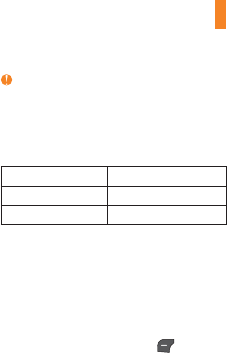
Preview Tab
Ź
Video Size: Allows you to select a vide size
between 320*240 or 176*144.
Ź
Brightness: Adjust brightness with a slider
by using the navigation key.
Ź
Color Effects: Allows you to choose from
Color, Mono, Sepia, or Negative.
Ź
White Balance: Set the White Balance
as Auto, Daylight, Cloudy, Illuminate, or
Indoors.
Ź
Video Quality: Allows you to set video
quality to Super Fine, Fine, or Normal.
Ź
Duration: Set the recording duration to
Normal Mode, Video Share Mode, or MMS
Mode.
Others Tab
Ź
Hide Icons: Select from Auto or Manual.
Ź
Voice: Mute/Unmute.
Ź
Recording Tones: On/Off
Ź
Reset Settings: Allows you to set the
Camcorder to the default settings.
Note
In Video Record mode, you can adjust the zoom
scale by using the up/down side volume keys.
The maximum zoom scale depends on the
resolution as follows.
Resolution Zoom scale
320*240 Level 1~Level 10
176*144 Level 1~Level 10
Camera Album
Allows you to view the pictures and videos that
are captured with the camera. When a file is
highlighted, the following options are available
when you press the left soft key Options:
For image file:
Use/Send Via/Print Via Bluetooth/Delete/
Rename/Select Multiple/Information.
For video file:
Video Share Call/Send Via/Delete/
Rename/Select Multiple/Information
My Stuff

Record Voice
Allows you to record an audio clip to your
phone. The recorded audio file is saved
automatically in the Audio menu.
The following options are available when you
press the left soft key Options:
Ź
Record Mode: Sets the recording mode to
either MMS Mode or General Mode.
Ź
Quality: Allows you to set the quality of an
audio clip. You can set it to Fine, Normal,
or Economy
Ź
Set Storage Defaults: You can set the
default storage of the recorded audio to the
Phone Memory or the Memory Card.
Pressing the left soft key Gallery will take
you to the Audio gallery.
Other Files
When you receive files of an undefined format
(such as .vcs, .vcf, etc.) via email, the files are
saved in this folder.
To access Other Files, from the standby screen,
press the right soft key Menu, My
Stuff, and Other Files.
The following options are available:
Ź
Send Via: Send the selected file via
Bluetooth or MMS.
Ź
Delete: Allows you to delete the selected
file.
Ź
Move: Allows you to move the selected file
to another folder.
Ź
Copy: Allows you to copy the selected file
to another folder.
Ź
Rename: Allows you to edit the name of
the selected file.
Ź
Select Multiple: Allows you to select
multiple files at once to perform various
functions.
Ź
Sort By: Allows you to sort the files by
Name, Date, and Type.
Ź
Information: Allows you to view
information about the selected file or used
memory space on your phone or memory
card.
My Stuff

File Manager
This function allows you to view the content in
your internal phone memory and the external
memory card.
To access File Manager, from the standby
screen, press the right soft key Menu,
My Stuff, and File Manager.
My Stuff

Settings
Audio & Ringtones
This menu allows you to configure the audio
and ringtone settings for your phone.
To access Audio & Ringtones, from the standby
screen, press the right soft key Menu,
Settings, and Audio & Ringtones.
Shop Tones
Connects to the
AT&T
AT&T Ringtones download site.
Ringtone
Ź
Sounds: Allows you to set a sound as the
ringtone for your phone.
Ź
Volume: Allows you to control your
Ringtone volume.
Ź
Alert Type: Supports 3 ring alert types:
Ring, Ring and Vibration, and Ring after
Vibration.
Ź
Increasing Ringtone: Allows you to
enable or disable the Increasing Ringtone
funcion, which is played when you receive
an incoming call.
Note
Full length music tracks cannot be set as either
ringtones or message tones.
Message Tone
Ź
Sounds: Allows you to set a sound as your
message tone.
Ź
Volume: Allows you to control your
Message Tone volume.
Ź
Alert Type: Supports 6 message alert
types: Ring Once, Ring Every 2 Min., Ring
Every 15 Min., Ring & Vibrate, Vibrate,
and Silent.
Alert Tone
Ź
Sounds: Allows you to select a set of alert
tones. Supports 2 alert tone types: Alert
Tone 1 and Alert Tone 2.
Ź
Volume: This menu allows you to control
your Alert Tone volume.
Ź
Alert Type: You can select to turn Alert
Tones to Ring or Silent.

Keypad Tone
This menu option allows you to select a tone
that the phone sounds when a key is pressed
on the dialpad. You can select an option from
Beep and Voice and set the volume.
Multimedia
This menu allows you to control your
Multimedia volume.
Call
This menu allows you to control your Call
volume.
Phone Settings
This menu allows you to configure the Phone
Settings. To access Phone Settings, from
the standby screen, press the right soft key
Menu, Settings, and Phone
Settings.
Date & Time
Ź
Set Date: This allows you to enter the
day, month, and year. You can set to Auto
Update with the Auto Update menu.
Ź
Date Format:
ddd, MMM DD (day, month date)
MM/DD/YYYY (month/date/year)
DD/MM/YYYY (date/month/year)
YYYY/MM/DD (year/month/date)
Ź
Set Time: This allows you to enter the
current time. You can choose the time
format via the Time Format menu option.
Ź
Time Format: 12 Hours/24 Hours
Ź
Auto Update: Allows you to set the phone
to automatically update the time and date
according to the current local time zone.
Settings

Languages
Allows you to change the language for the
display text on your phone. This change will
also affect the Language Input mode.
Set Hotkeys
Allows you to change the preferences on the
Hotkeys that are currently assigned for your
navigation keys (when in standby mode).
Set Flight Mode
This allows you to only use the phone’s
features that do not require the use of the
wireless network when you are in an airplane
or in places where the wireless network is
prohibited. If you set the flight mode on, the
flight mode icon will be displayed on the
screen instead of the network signal icon.
Ź
On: You cannot make (or receive) any calls,
including emergency calls, or use other
features that require network coverage.
Ź
Off: You can deactivate the flight mode to
access the network.
Security
Various codes and passwords are used to
protect the features and settings of your phone.
Ź
Phone Lock: You can use a security code
to avoid unauthorized use of the phone.
If you set the Phone Lock to When Power
On, the phone will request a security
code whenever you switch the phone on.
If you set the Phone Lock to When SIM
Card changed, your phone will request a
security code only when you change your
SIM Card. If you set the Phone Lock to
Lock Phone Now, your phone will lock
immediately.
Ź
PIN Code Request: When the PIN Code
Request feature is turned on, you must
enter your PIN each time you switch the
phone on. Consequently, any person who
does not have your PIN cannot use your
phone without your approval.
Note
Before setting the PIN Code Request feature off,
you must enter your PIN.
Settings

Ź
Fixed Dial Number: This feature allows
you to restrict your outgoing calls to
selected phone numbers, if supported by
your SIM Card. The PIN2 code is required.
• FDN On/Off
- On: You can only call phone numbers
stored in the FDN List. You must enter your
PIN2 code.
- Off: You can call any number.
• FDN List: Allows you to enter a new FDN
entry.
Ź
Change Codes: The Change Codes feature
allows you to change your current password
to a new one. You must enter the current
password before you can specify a new
one. You can change the access codes for:
Security Code, PIN Code, PIN2 Code.
Note
Not all SIM Cards have a PIN2 Code. If your SIM
Card does not, this menu option is not displayed.
Ź
PTT Key Lock: Allows you to enable or
disable the PTT Key Lock.
Reset Settings
This function allows you to restore factory
settings. To do this, you need the security code.
Ź
Master Reset: Restores the phone settings
(e.g.: Audio, Display, Language, Date &
Time, Bluetooth Settings) to default values.
Ź
Master Clear: Deletes downloaded/user
created contents (e.g.: images, videos) from
the phone and the external memory card.
• Phone
- Deletes all downloaded/user created
images and audios from the phone
memory.
- Deletes personal information stored
in the phone memory (e.g.: Address
Book, Messages, Tasks, Alarm, Calendar
Schedules).
- Restores the settings stored in the phone
memory to the default values.
• Memory Card: Deletes all contents from the
external memory card.
Settings

Display
This menu allows you to configure your Display
settings.
To access Display, from the standby screen,
press the right soft key Menu,
Settings, and Display.
Shop Wallpapers
Connects to
AT&T
AT&T’s Color Graphics download
site.
Wallpapers
This menu allows you to set a picture or color
as your background.
Fonts
You can configure the font size and color of the
font that your phone uses.
Clocks & Calendar
This feature allows you to select a Clock or
Calendar to display on the Main & Extenal
Screen.
Brightness
You can set the brightness of the display
screen and the keypad.
Backlight Timer
Use this to set the duration of the display
backlight and keypad.
Color Schemes
Allows you to change the whole look of your
phone display to a Black or White scheme.
Menu Styles
You can set the main menu style to Icon or
List view.
Call
This menu allows you to configure your Call
settings.
To access Call, from the standby screen, press
the right soft key Menu, Settings,
and Call.
Settings

Call Forwarding
When this network service is activated, you can
direct your incoming calls to another number,
for example, to your voice mailbox number. For
details, contact
AT&T
AT&T.
The following options are available:
Ź
All Voice Calls: Diverts voice calls
unconditionally.
Ź
If Busy: Diverts voice calls when the phone
is in use.
Ź
If No Answer: Diverts voice calls which you
do not answer.
Ź
If Out of Reach: Diverts voice calls
when the phone is switched off or out of
coverage.
Send My Number
This network service allows you to set your
phone number to be displayed or hidden from
the person you are calling. You can select Set
by Network if you prefer to have different
settings for different service providers.
Auto Redial
If set to On, your phone redials the number
you’re trying to call up to 10 times after you
hear a quick, busy signal. Press [END] to
stop the call attempts.
This feature attempts to redial numbers that
are engaged due to the wireless network. It
does not redial numbers to an engaged party.
Note
There will be no alert indicating the call has been
connected. You must stay on the line to hear
when the call is connected.
Answer Mode
This allows you to determine how to answer
the phone.
Ź
Any Key: Allows you to answer an
incoming call by pressing any key, except
the [END] key, side volume keys, or
the right soft key Silent.
Ź
Send Key Only: Allows you to only answer
an incoming call by pressing the
[SEND] key or left soft key Accept.
Settings

Ź
Flip Open: Allows you to Flip open the
phone to answer an incoming call.
Senior Mode
This option allows you to turn the senior
mode on or off. Senior mode enhances high
frequencies to reduce the effects of hearing
loss.
Minute Minder
This option allows you to specify whether
the phone will beep every minute during an
outgoing call to keep you informed of the
length of the call.
Call Waiting
The network will notify you of a new incoming
call while you have a call in progress. Select
Activate to request the network to activate call
waiting, Deactivate to request the network
to deactivate call waiting, or View Status to
check if the function is active or not.
Call Reject
This menu allows you to enable or disable call
reject for all numbers or just the numbers on
the Call Reject List.
Ź
Call Reject On/Off: Allows you to activate
or deactivate Call Reject. When the Reject
All Calls option is set, all incoming calls
are routed directly to Voicemail. Reject on
List allows you to enable Call Reject for the
numbers saved on your Call Reject List.
Ź
Call Reject List: Allows you to view a
list of the numbers you wish to reject and
add new numbers to the list. You have
the option of choosing numbers from your
Contact List or adding a new number.
Send DTMF Tones
Select from On/Off.
Accessability
TTY
Allows you to enable TTY Mode in order to
contact other TTY devices. Select from TTY
Full/TTY Talk/TTY Hear/TTY Off.
Hearing Aid
Time & Cost
Allows you to view information about Call
Duration and Data Counter.
Settings

Noise Cancelation
Connection
This menu allows you to configure your
Connection settings.
To access Connection, from the standby
screen, press the right soft key Menu,
Settings, and Connection.
Bluetooth
Your phone has built-in Bluetooth wireless
technology, which makes it possible for
you to connect your phone wirelessly to
other Bluetooth devices such as a hands-
free device, PC, PDA, or other phones.
The devices registered in your phone can
only be connected one at a time (To make
a connection to the same type of device or
change Bluetooth preferences, disconnect the
existing device first).
You can also exchange, for example, business
cards, calendar items, and pictures.
To access Bluetooth, from the standby
screen, press the right soft key Menu,
Settings, Connection, and
Bluetooth.
Hands-free profile
This appears when the hands-free profile
is used between the hands-free device. This
allows you to call using a Bluetooth connection.
A2DP profile
This appears when the A2DP profile is
used between the stereo headset device and
the phone. This allows you to listen to an audio
clip. A2DP is the Advanced Audio Distribution
Profile, which provides support for streaming
either mono or stereo audio using Bluetooth.
Hands-free + A2DP profile
This appears when both profiles of the
hands-free and the A2DP are used between
the compatible device and the phone. This
allows you to call and listen to an audio clip
using a Bluetooth connection.
When using each device, see the manual that
comes with the device.
Note
We recommend that your phone and the
Bluetooth device you are communicating with
should be no more than 10 meters apart. The
connection may be improved if there are no
solid objects between your phone and the other
Bluetooth device.
Settings

Bluetooth Menu Options
Ź
Turn On/Off: Allows you to turn your
Bluetooth functionality on or off.
Ź
My Visibility On/Off
- On: This option makes your phone visible
to other Bluetooth devices.
- Off: This option hides your phone from
other Bluetooth devices except those
already paired with yours.
Ź
Search New Device: This function allows
you to search for and add new devices.
To pair with another device
From the standby screen, press the right
soft key Menu, Settings,
Connection, Bluetooth, and
Search New Device.
If you want to stop searching, press the left
soft key Stop.
All of the devices found are displayed.
Select the desired device by pressing
Add and entering the password.
Ź
My Devices: This function allows you to
view the list of all devices that are paired
with your phone.
1.
2.
3.
4.
Ź
My Bluetooth Info: This menu allows you
to configure the profile for Bluetooth.
- My Device Name: Allows you to change
the handset’s name which can be seen by
other Bluetooth devices.
- Supported Services: Shows you all
services that the handset supports.
- Primary Storage: Allows you to assign
the default storage to Handset or Memory
Card for files received via Bluetooth.
USB Connection Mode
You can transfer files from a compatible
PC to the memory in your phone using the
Mass Storage Mode. When you connect the
phone to a PC using the USB cable, this will
be displayed as a removable disk through
Windows Explorer.
The USB Connection Mode determines how
your phone will communicate with other USB
devices when they are connected with a USB
cable.
Settings

Internet Profiles
This menu shows the Internet Profiles. You
can add, delete, and edit Internet Profiles
by pressing the left soft key Options.
However, you cannot delete or edit default
configurations provided by
AT&T
AT&T.
Access Points
This menu shows the Access Points. You can
register, delete, and edit by pressing the left
soft key Options. However, you cannot
delete or edit default configurations provided
by
AT&T
AT&T.
Memory
This menu allows you to configure your
Memory settings.
To access Memory, from the standby screen,
press the right soft key Menu,
Settings, and Memory.
Used Space
This function shows the memory status of the
handset and memory card (if inserted).
Ź
Phone Common
This function shows the Memory Status
of the phone and the memory being
used by Audio, Image, Video, Multimedia
Message, Java, and Others types of files.
Ź
Phone Reserved
This function shows the status of
the reserved memory used by Text
Messages, Contacts, Calendar items,
Tasks, and the Notepad.
Ź
Memory Card
If your phone has a memory card in the
card slot, you can save images, sounds,
and videos onto it. You can check the
current status of the external memory
card in this memory status menu.
Ź
SIM Card
This function shows the status of the SIM
Card memory.
Set Storage Defaults
This menu allows you to set the storage default
location for internet downloads, Bluetooth
transfers, and voice recordings. You can set
each case separately or choose to set all of
them at once.
Settings

Application Settings
This Menu allows you to configure Application
Settings.
To access Application Settings, from the
standby screen, press the right soft key
Menu, Settings, and Application
Settings.
Video Share
Ź
Audio Alert: Allows you to enable or
disable the audio alert that sounds when
Video Share is available during a call.
Ź
Auto Record: Allows you to enable or
disable the option to automatically record
the video you are sharing through Live
Video Share.
Browser
This menu allows you to configure the Browser
settings.
Accounts
This includes the network information used
to connect the browser to the Internet. Select
the desired account by highlighting it and
pressing the left soft key Activate. This
will activate the account that will be used for
future connections.
Ź
Activate: Select the account among the
list of accounts, so it can be used for future
connections.
Ź
View: Allows you to see the specific
account information.
The following options will be available when
you press on the left soft key Options:
Ź
Edit: Allows you to change the account
information. This option is not available for
the default Account.
Ź
Delete: Allows you to delete the account.
Ź
New: Allows you to create new account.
Settings

Note
•
You cannot edit and delete pre-installed
accounts.
•
In order to create a new account, please fill in
the network information.
1.
Account Name: Name associated with new
account.
2.
Homepage: Homepage URL.
3.
Internet Profile: You can choose one from the
Internet profiles.
•
AT&T
AT&T has provided default settings regarding
account information.
•
Creating or editing an account requires
caution. The browser cannot connect to the
Internet if the account information is incorrect.
Appearance
You can choose the settings of the browser
appearance (Text size, Character Encoding,
Scrolling Control, Show Image, JavaScript).
Cache
The web pages you have accessed are stored
in the phone memory. This menu allows you to
manage that function.
Ź
Clear Cache: Remove all cached data in
the memory.
Ź
Allow Cache: Allows you to turn the
memory cache on or off.
Note
Cache is a type of buffer memory, which is
used to store data temporarily, especially when
it is online.
Cookies
The information of services you have accessed
are stored in what is called a Cookie.
From this menu, you can choose to Allow
Cookies or to Delete Cookies that are already
on your phone.
Settings

Screen Settings
You can change the settings of the browser
screen (Rendering).
Security
A list of the available certificates is shown.
Ź
Certificates: You can see the list of
certificates and view them in detail.
Ź
Clear Session: Removes the secure
session.
Navigation Mode
You can change the methods of browser
navigation.
Ź
4 Way Navigation: The cursor of the
browser moves scroll amounts or follows
hyperlinks.
Ź
Mouse Pointer: You can move the cursor
like a mouse pointer.
Secure Pop-up
You can activate or deactivate the pop-up
which indicates a secure page.
Browser Shortcut
If set to On, you can use the alternative
browser (found in Menu > My Stuff >
Applications > Browser) more quickly and
conveniently with the key pad in the phone. If
Browser Shortcut is on, the following shortcuts
are available:
1. Enter URL
3. View Bookmarks
5. Full Screen
7. Page Up
9. Zoom In
*. Page Down
2. This Page
4. Page Overview
6. Saved Pages
8. Recent Page
0. Search Text
#. Zoom Out
Voice Command
• Mode
- Speed: Voice command is abbreviated.
- Normal: Voice Command is played
normally with prompts.
• Best Match
- 1 Match: The most likely match will be
displayed when finding a number from the
address book.
Settings

Settings
- 4 Matches: The four most likely matched
names will be displayed when finding a
name from the address book.
• Sensitivity: Choose between High, Medium,
and Low.
• Speakerphone Mode
- Automatic On: When this option is
selected, sound is loud enough so you can
hear the output when the phone is away
from the ear, at a distance.
- Off: When this option is selected, sound
is quieter and cannot be heard when the
phone is away from the ear, at a distance.
• Call Alert
- Ring Only: The phone rings repeatedly
during an incoming call.
- Ring After Name: The phone announces
the name and number of the incoming
call, then rings repeatedly.
- Name Repeat: The phone announces an
incoming call by repeating the name or
number of the caller.
Software Update
If new software exists, the
AT&T
AT&T server notifies
devices using a push message.
The user can also check for the software
update using the menu “Check for Update”.
If the new software does not exist the user can
not use this feature in 24 hours.
Before updating new software after
downloading it from the
AT&T
AT&T server, users can
decide whether they would like to postpone
the operation. Reminder times can be set to
30 minutes, 1 hour, and 4 hours. When the
time is up, users are prompted again or users
can resume the postponed operation using this
menu at any time.
The software update can only be postponed
three times and will automatically start after
the third postpone period expires.
To access Software Update, from the standby
screen, press the right soft key Menu,
Settings, and Software Update.

Settings
Phone Information
This menu is used to view My Numbers,
Manufacturer, Model Name, Device ID,
Hardware Version, Software Version, Language,
and DM Client Version.
To access Phone Information, from the standby
screen, press the right soft key Menu,
Settings, and Phone Information.

FCC Hearing-Aid Compatibility (HAC)
Regulations for Wireless Devices
On July 10, 2003, the U.S. Federal Communications Commission
(FCC) Report and Order in WT Docket 01-309 modified the
exception of wireless phones under the Hearing Aid Compatibility
Act of 1988 (HAC Act) to require digital wireless phones be
compatible with hearing-aids. The intent of the HAC Act is to
ensure reasonable access to telecommunications services for
persons with hearing disabilities.
While some wireless phones are used near some hearing devices
(hearing aids and cochlear implants), users may detect a buzzing,
humming, or whining noise. Some hearing devices are more
immune than others to this interference noise, and phones also
vary in the amount of interference they generate.
The wireless telephone industry has developed a rating system for
wireless phones, to assist hearing device users to find phones that
may be compatible with their hearing devices. Not all phones have
been rated. Phones that are rated have the rating on their box or a
label located on the box.
The ratings are not guarantees. Results will vary depending on the
user's hearing device and hearing loss. If your hearing device
happens to be vulnerable to interference, you may not be able to
use a rated phone successfully. Trying out the phone with your
hearing device is the best way to evaluate it for your personal
needs.
M-Ratings: Phones rated M3 or M4 meet FCC requirements and
are likely to generate less interference to hearing devices than
phones that are not labeled. M4 is the better/higher of the two
ratings.
T-Ratings: Phones rated T3 or T4 meet FCC requirements and are
likely to generate less interference to hearing devices than phones
that are not labeled. T4 is the better/ higher of the two ratings.
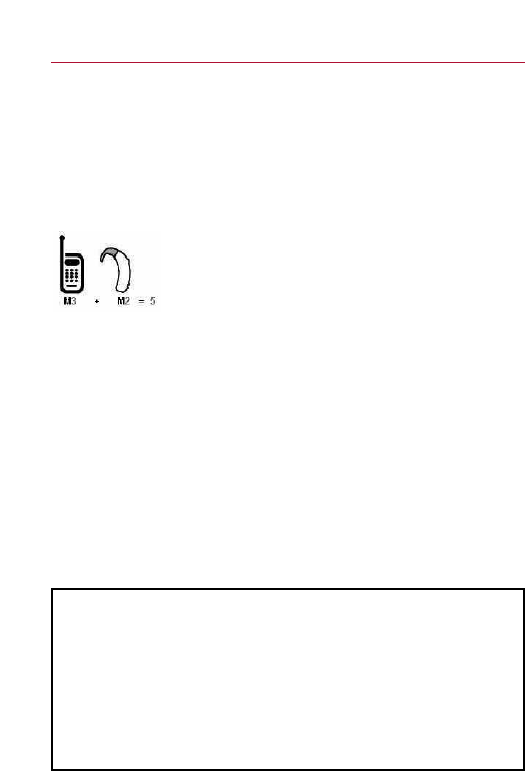
Hearing devices may also be rated. Your hearing device
manufacturer or hearing health professional may help you find this
rating. Higher ratings mean that the hearing device is relatively
immune to interference noise. The hearing aid and wireless phone
rating values are then added together. A sum of 5 is considered
acceptable for normal use. A sum of 6 is considered for best use.
In the example to the left, if a hearing aid meets
the M2 level rating and the wireless phone meets
the M3 level rating, the sum of the two values
equal M5. This should provide the hearing aid user
with “normal usage” while using their hearing aid
with the particular wireless phone. “Normal usage” in this context
is defined as a signal quality that’s acceptable for normal
operation.
The M mark is intended to be synonymous with the U mark. The T
mark is intended to be synonymous with the UT mark. The M and T
marks are recommended by the Alliance for Telecommunications
Industries Solutions (ATIS). The U and UT marks are referenced in
Section 20.19 of the FCC Rules. The HAC rating and measurement
procedure are described in the American National Standards
Institute (ANSI) C63.19 standard.
When you're talking on a cell phone, it's recommended that you
turn the BT (Bluetooth) mode off for HAC.
For information about hearing aids and digital wireless phones
Wireless Phones and Hearing Aid Accessibility
http://www.accesswireless.org/hearingaid/
FCC Hearing Aid Compatibility and Volume Control
http://www.fcc.gov/cgb/consumerfacts/hac_wireless.html

※ HAC statement
This phone has been tested and rated for use with
hearing aids for some of the wireless technologies
that it uses.
However, there may be some newer wireless
technologies used in this phone that have not been
tested yet for use with hearing aids.
It is important to try the different features of this phone
thoroughly and in different locations, using your hearing
aid or cochlear implant, to determine if you hear any
interfering noise.
Consult your service provider or the manufacturer of this
phone for information on hearing aid compatibility.
If you have questions about return or exchange policies,
consult your service provider or phone retailer.
.
.
.
.
※ Hearing Aid mode (T-coil mode)
If you select on, users using hearing aids with T-coil will
have better quality of sound. This T-coil mode will remain
on during the voice call.